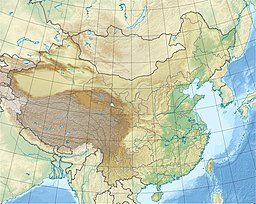Guanyinge Reservoir
Appearance
| Guanyinge Reservoir 观音阁水库 | |
|---|---|
| Location | on the Taizi River[1] |
| Coordinates | 41°22′41″N 124°16′16″E / 41.37806°N 124.27111°E |
| Type | Reservoir[2] |
| Basin countries | China |
| Built | May 1990 |
Guanyinge Reservoir (Chinese: 观音阁水库[3]) is a large reservoir[4] located on the main stream of the Taizi River in[5] Benxi County, Liaoning province, China.[6] Its water surface is 62 square kilometers,[7] with a total storage capacity of 2.2 billion cubic meters.[8]
Guanyinge Reservoir is a Sino-Japanese cooperation project [9] and a key project of the province and the Chinese Ministry of Water Resources.[10] With a total investment of 1.568 billion yuan,[11] of which 11.78 billion is in Japanese yen.[12]
The main part of the reservoir was begun in May 1990[13] and completed in September 1995.[14]
References
[edit]- ^ Zhengying Qian (1994). Water Resources Development in China. China Water & Power Press. pp. 125–. ISBN 978-7-120-01717-0.
- ^ Feng Guisheng (1 July 2012). Liaoning Theory of Regional Economic Development. Liaoning People's Publishing House. pp. 417–. ISBN 978-7-205-07396-1.
- ^ "Graphical Benxi Ecological Industry". Xinhua News Agency. 11 May 2017.[permanent dead link]
- ^ Lina Wang (30 November 2020). A study on the mechanisms related to pollution control in circular economy. Scientific Research Publishing. pp. 269–. ISBN 978-1-61896-995-8.
- ^ China Agriculture Yearbook. China Agriculture Press. 1991. pp. 39–.
- ^ "Safety Analysis and Comperehensive Evaluation on Guanyinge Reservoir in Liaoning Province". CNKI. 9 October 2010.[permanent dead link]
- ^ China Today. China Welfare Institute. 1998. pp. 118–.
- ^ Mohamed Ariff (1998). APEC & Development Co-operation. Institute of Southeast Asian Studies. pp. 109–. ISBN 978-981-230-020-1.
- ^ "Introduction to Guanyinge Reservoir". Xinhua News Agency. Archived from the original on 11 September 2003. Retrieved 28 December 2020.
- ^ Wang Koon (2005). Japan's Strategic Thinking on China's ODA and its Impact on Sino-Japanese Relations. China Social Science Press. pp. 83–. ISBN 978-7-5004-5037-5.
- ^ Jin Xide (2001). Japanese Diplomacy and Sino-Japanese Relations: New Trends in the 1990s. World Knowledge Press. pp. 317–. ISBN 978-7-5012-1500-3.
- ^ Chinese Communist Party history materials. Chinese Communist Party History Press. 2004. pp. 118–. ISBN 978-7-80136-997-0.
- ^ 50 Years of Chinese Water Resources. China Water Conservancy and Hydropower Publishing House. 1999. pp. 125–. ISBN 978-7-5084-0206-2.
- ^ China Economic Yearbook. Economic Management Press. 1996. pp. 219–.


